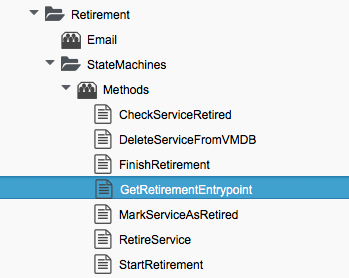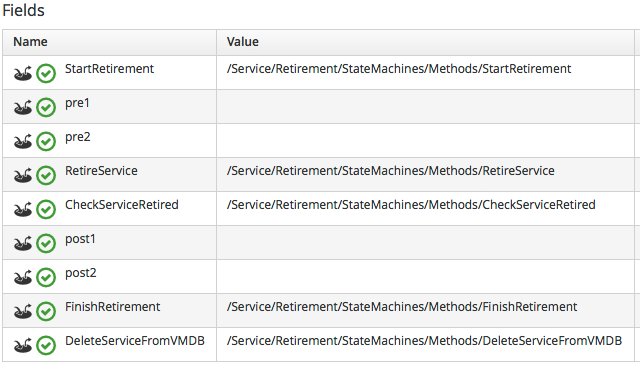Retirement
The Retirement process for VMs, Instances and Services was substantially re-written for ManageIQ Botvinnik (CloudForms Management Engine 5.4). This section describes the workflow in ManageIQ Capablanca (CloudForms Management Engine 5.5).
VM and Instance Retirement
VM or Instance retirement is initiated from the Lifecycle menu on the VM details page:

This raises a request_vm_retire event that enters the Event Switchboard as an MiqEvent/POLICY event:

This is redirected to a Cloud or Infrastructure (as appropriate) /VM/Lifecycle/Retirement Instance:

The Lifecycle/Retirement Instance redirects us into the desired VM Retirement State Machine (Default for Cloud Instances, Default or Unregister for Infrastructure VMs):

Retirement-Related Attributes and Methods
A VM object has a number of retirement-related methods:
$evm.root['vm'].start_retirement
$evm.root['vm'].finish_retirement
$evm.root['vm'].retire_now
$evm.root['vm'].retired?
$evm.root['vm'].retirement_state=
$evm.root['vm'].retirement_warn=
$evm.root['vm'].retires_on=
$evm.root['vm'].retiring?
It also has several attributes:
$evm.root['vm'].retired = nil
$evm.root['vm'].retirement_last_warn = nil
$evm.root['vm'].retirement_requester = nil
$evm.root['vm'].retirement_state = nil
$evm.root['vm'].retirement_warn = nil
$evm.root['vm'].retires_on = nil
During the retirement process some of these are set to indicate progress:
$evm.root['vm'].retirement_requester = admin (type: String)
$evm.root['vm'].retirement_state = retiring (type: String)
and completion:
$evm.root['vm'].retired = true (type: TrueClass)
$evm.root['vm'].retirement_requester = nil
$evm.root['vm'].retirement_state = retired (type: String)
$evm.root['vm'].retires_on = 2015-12-10 (type: Date)
VM Retirement State Machine
The VM Retirement State Machines(s) undo many of the operations performed by the VM Provisioning State Machine. They allow us to optionally deactivate a CI record from a CMDB, unregister from DHCP, Active Directory and DNS, and release both MAC and IP addresses.

StartRetirement
The StartRetirement Instance calls the start_retirement State Machine Method, which checks whether the VM is already in state 'retired' or 'retiring', and if so it aborts. If in neither of these states it calls the VM's start_retirement method, which sets the retirement_state attribute to 'retiring'.
PreRetirement / CheckPreRetirement
The State Machine allows us to have Provider-specific Instances and Methods for these stages, but the out-of-the-box PreRetirement Instance runs a vendor-independant pre_retirement Method that just powers off the VM. CheckPreRetirement checks that the power off has completed.
RemoveFromProvider / CheckRemovedFromProvider
The RemoveFromProvider stage allows us some flexibility in handling the actual removal of the VM, and this is where the Default and Unregister State Machines differ.
Default
The RemoveFromProvider stage of the Default State Machine links to the RemoveFromProvider Instance, which calls the remove_from_provider State Machine Method, passing the argument removal_type => 'remove_from_disk'. This checks whether the VM was provisioned from CloudForms/ManageIQ (vm.miq_provision is not nil ), or if the VM is tagged with lifecycle/retire_full. If either of these is true it fully deletes the VM from the underlying provider, including the disk image. Having done so it sets a boolean state variable vm_removed_from_provider to true.
If neither of these checks returns true, no action is performed.
Unregister
The RemoveFromProvider stage of the Unregister State Machine links to the UnregisterFromProvider Instance, which calls the remove_from_provider State Machine Method, passing the argument removal_type => 'unregister'. This checks whether the VM was provisioned from CloudForms/ManageIQ (vm.miq_provision is not nil ), or if the VM is tagged with lifecycle/retire_full. If either of these is true it deletes the VM from the underlying provider, but retains the VM's disk image, allowing the VM to be re-created if required in the future. Having done so it sets a boolean state variable vm_removed_from_provider to true.
If neither of these checks is true, no action is performed.
FinishRetirement
The FinishRetirement Instance calls the finish_retirement State Machine Method that sets the following VM object attributes:
:retires_on => Date.today
:retired => true
:retirement_state => "retired"
It also raises a vm_retired event that can be caught by an Automate action or Control Policy.
DeleteFromVMDB
The DeleteFromVMDB Instance calls the delete_from_vmdb State Machine Method, that checks for the state variable vm_removed_from_provider, and if found (and true) it removes the VM record from the VMDB.
Service Retirement
Defining a Service Retirement Entry Point
When we create a Service Catalog Item, we can optionally specify a Retirement Entry Point:

If we specify our own Retirement Entry Point, then this State Machine will be used to retire any services created from this Catalog Item, rather than the Default.
Retiring the Service
Service retirement is initiated from the Lifecycle menu on the Service details frame:

This raises a request_service_retire event that enters the Event Switchboard as an MiqEvent/POLICY event:

which redirects to /Service/Retirement/StateMachines/Methods/GetRetirementEntryPoint:

This Instance runs a Method get_retirement_entry_point that returns the Retirement Entry Point defined when the Service Catalog Item was created. If this is empty then /Service/Retirement/StateMachines/ServiceRetirement/Default is returned.
Retirement-Related Attributes and Methods
A Service object has a number of retirement-related methods:
$evm.root['service'].automate_retirement_entrypoint
$evm.root['service'].finish_retirement
$evm.root['service'].retire_now
$evm.root['service'].retire_service_resources
$evm.root['service'].retired?
$evm.root['service'].retirement_state=
$evm.root['service'].retirement_warn=
$evm.root['service'].retires_on=
$evm.root['service'].start_retirement
and attributes:
$evm.root['service'].retired = nil
$evm.root['service'].retirement_last_warn = nil
$evm.root['service'].retirement_requester = nil
$evm.root['service'].retirement_state = nil
$evm.root['service'].retirement_warn = nil
$evm.root['service'].retires_on = nil
Default Service Retirement State Machine
The Default Service Retirement State Machine is simpler than its VM counterpart:

StartRetirement
The StartRetirement Instance calls the start_retirement State Machine Method, which checks whether the Service is already in state 'retired' or 'retiring', and if so it aborts. If in neither of these states it calls the Service's start_retirement method, which sets the retirement_state attribute to 'retiring'.
RetireService / CheckServiceRetired
The RetireService Instance calls the retire_service State Machine Method, that in turn calls the Service object's retire_service_resources method. This method calls the retire_now method of every VM comprising the Service, to initiate their retirement. CheckServiceRetired retries the stage until all VMs are retired or deleted.
FinishRetirement
The FinishRetirement stage sets the following Service object attributes:
:retires_on => Date.today
:retired => true
:retirement_state => "retired"
It also raises a service_retired event that can be caught by an Automate action or Control Policy.
DeleteServiceFromVMDB
The DeleteServiceFromVMDB Instance calls the delete_service_from_vmdb State Machine Method, which removes the Service record from the VMDB.